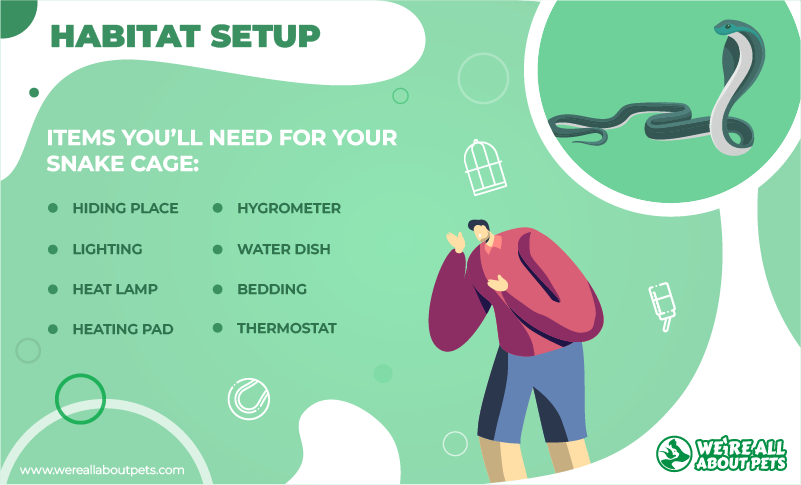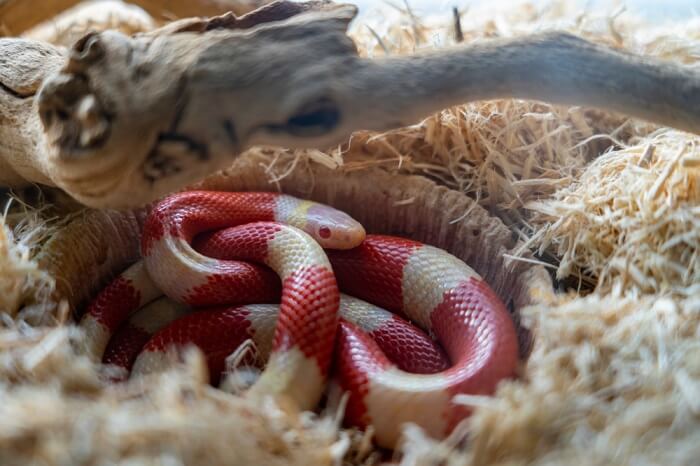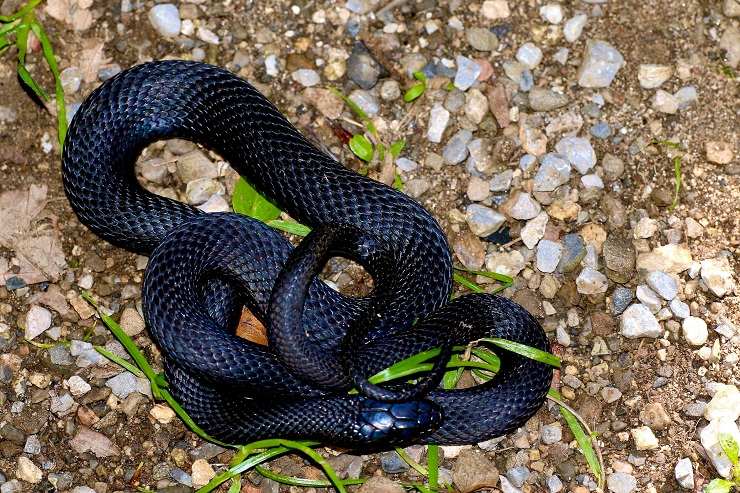How To Care For A Snake
This page contains affiliate links. We may earn money or products from the companies mentioned in this post through our independently chosen links, which earn us a commission. Learn More
General Stats:
- Pet Type: Reptile
- Size: Up to 30 feet
- Diet: Carnivore
- Lifespan: 15 to 30 years
If you’re thinking about getting a new pet but you want to go outside the box of traditional pets like cats and dogs, a snake might be worth considering. These pets require a different level of care than other pets, but they can be incredibly interesting and unique.
Before you settle on a snake as your new pet, do some research and check out a snake care guide or two to get a feeling for what you’re getting yourself into. Think about the different snake species and decide which option is best for you. From there, you get research the specifics about that type of snake.
Here’s some general information you need to know about proper snake care.
Habitat Setup For Snakes

A snake is not the type of pet you generally let roam around your house, so your most important point of order in getting your first snake is to choose the right terrarium or tank. Your snake’s new home should mimic his natural habitat as much as possible, so you’ll need to decide which among the different snake breeds you want to keep in order to know what kind of environment you need to create.
The size of your snake terrarium will depend on the size and activity level of your snake. A ball python needs about 6 to 8 square feet of space as an adult while a corn snake may be kept in a standard 20-gallon tank. Larger snakes like kingsnakes need a little more space and other species may need less.
In addition to the size of the tank, consider the dimensions as well. Any snake should be able to fully extend its body in the enclosure. Arboreal species that like to climb prefer tall tanks to wide tanks, so check out a snake care guide or talk to the reptile expert at your local pet stores to get an idea what option will work best for you. It’s best to check multiple resources to be sure the information matches. You can also look for who wrote the material to help make sure you’re getting good advice from experts.
Here are some of the items you may need for your snake cage:
- Hiding Place – Many snakes don’t follow a strict nocturnal or diurnal sleep pattern, but they will need a hiding place to retreat to when they want to rest or cool off. A hide helps your snake feel secure.
- Lighting – Most snakes need 8 to 12 hours of light per day and do best when it’s kept on a regular cycle. Consider using an automatic timer to turn lights off at night. Most snakes don’t need UVB light but do some research on different snake species to be sure. There’s emerging evidence that some snakes may benefit from low-level UVB.
- Heat Lamp – In addition to lighting, your snake may need a heat lamp to maintain the proper tank temperature and to create a basking area.
- Heating Pad – Some snakes need a very warm environment so you may need a heating pad to keep up the ambient temperature in the tank. Use a thermostat to track the temperature.
- Hygrometer – Snakes that live in tropical and subtropical regions may require higher humidity than other species. A hygrometer will help you monitor the humidity in your snake’s habitat.
- Water Dish – Provide a shallow dish or fresh water that won’t tip over. Snakes require access to water for drinking as well as for soaking.
- Bedding – The best bedding for your snake depends on the type of environment you’re trying to create and the species of snake. If you use wood shavings, make sure they are finely shredded. You can also use coconut fiber, cypress mulch, sand, newspaper, or even paper towels.
Set up your snake’s habitat to mimic his natural environment as much as possible. Proper reptile care can be tricky to learn, but once you get the hang of it it’s largely a matter of maintaining stable conditions in the snake habitat and feeding your new pet a healthy diet.
Snake Diet

The key to keeping your snake healthy is providing him with an appropriate diet. All snakes are carnivores, but the prey items your snake needs will vary depending on the kind of snake you have.
What you need to decide before choosing a diet for your snake is whether you want to feed live prey or killed prey. There are some significant risks to feeding live prey, so that should be done as a last resort. Frozen, thawed prey is best for your pet snake.
Here are some quick facts about the ideal snake diet:
- Most adult snakes will only eat a few times a month or less often – you’ll need to plan ahead to have the right prey available at the right time.
- When feeding rodents like rats and mice, it’s important to choose prey the right size for your snake – never feed your snake anything larger than your snake’s diameter.
- If your snake doesn’t eat the prey on the first feeding, you should use a fresh killed prey item. Saving it once thawed risks the rodent going bad.
- When feeding pre-killed prey, it’s a good idea to warm it to body temperature. For rodents, you can gently warm the rodent in warm water. Make sure the rodent can be held comfortably against the inside of your wrist before feeding. Also be sure that the prey is fully thawed. If it’s partially frozen when fed, your snake won’t be able to digest it.
- When feeding live prey, always directly supervise your pet snake. Snakes can become severely injured from rodents.
On top of your snake’s diet, be sure to provide unlimited access to clean water as well. Your snake will get most of its hydration from its prey, but fresh water should be available at all times.
Snake Veterinary Care

All pets require access to veterinary care, even if they never get sick. It’s always a good idea to take your new pet to the vet within a few weeks of bringing it home just to get a baseline for its health. Your vet will be able to detect potential health concerns so you can keep an eye on them. If you have multiple snakes, any new ones should be quarantined in a different room for at least 60 days and cleared by a veterinarian before having access to the same room as your other snakes.
Here are some of the most common health problems in snakes:
- Parasites
- Septicemia
- Infectious stomatitis
- Skin infections
- Respiratory disease
- Egg binding
- Nutritional deficiency
Most veterinarians aren’t properly trained to care for snakes, so you may need to find an exotics or reptile vet in your area. Be prepared to pay a little more for a vet visit than you might for a dog or cat. You can start your search here.
Snake Fun Facts

- Snakes are ectotherms which means they rely on external sources of heat to give them energy and to regulate their body temperature. They alternate between basking in the sun and hiding in the shade to keep their body temperature comfortable. They may also burrow to get heat from the ground.
- There are over 3,000 species of snake on the planet, naturally found everywhere except Antarctica, Iceland, Greenland, Ireland, and New Zealand. Only about 600 species of snake are venomous.
- Snakes have forked tongues that they use to “smell” their surroundings. Many also have pit holes in front of their eyes that sense heat, helping them locate warm-blooded prey. The bones in their lower jaws can also pick up vibrations.
- Most snakes shed their skin about once a month in a process called ecdysis. It makes room for the snake to grow and helps get rid of parasites as well.
- Snakes can be great escape artists, Snakes explore their habitat constantly, so they will always find an opening if it exists, and they don’t need a large opening to escape.
Keeping a pet snake can be a challenge, but once you get the hang of it, you’ll find it quite rewarding. Take what you’ve learned here about snake care and think about what kind of snake is the right fit for you. There are plenty of options to choose from!
Frequently Asked Questions
How long do snakes live?
The average lifespan for a pet snake is 15 to 30 years, depending on the species.
How much do snakes cost?
The cost to keep a pet snake varies, depending on the species. The biggest expense is generally the terrarium, including the necessary equipment for lighting and heating. You’ll spend anywhere from $30 to $200 to purchase one of the more popular species of pet snake and an additional $50 to $300 on a terrarium. Supplies cost anywhere from $100 to $300, depending on what you need. You should also factor in the cost of veterinary care when you adopt a new pet.
How big do snakes get?
Snakes range in size from as small as 4 inches to as large as 30 feet in length.
What do snakes eat?
All snakes are carnivores, but their natural diet varies by species. Many snakes eat warm-blooded prey like rodents and birds while others eat cold-blooded prey items like amphibians, fish, and other reptiles. Snakes swallow their food whole.
Are snakes good pets?
Whether a snake makes a good pet will depend on what you’re looking for and how much work you’re willing to put into care. They are certainly different from other reptiles like the bearded dragon, but some species are very gentle and can get used to be handled by their owner.
Are snakes messy?
Snakes are actually fairly clean pets, primarily because most species don’t eat every day and don’t excrete waste every day. It’s still a good idea to check and spot clean the tank on a daily basis, but you shouldn’t have to do much to keep it tidy.
Where do snakes come from?
Snakes can be found in almost every part of the world on every continent except Antarctica. Some other exceptions include islands like Hawaii and New Zealand. Ireland and Iceland also have no native snake species. There are many species in the United States and North America.
Do snakes bite?
Generally speaking, snakes do not bite unless they feel threatened. Certain snake species are more likely to bite than others, but you shouldn’t have to worry about it if you handle your snake appropriately.
Do snakes sleep?
Yes, just like all animals, snakes do sleep. Depending on the species that may occur at night or during the day. They have no eyelids, so you won’t see them close their eyes when they sleep.
How long are snakes pregnant?
Most snakes lay eggs rather than giving birth to live young. The gestation period for snakes is about 28 to 45 days, depending on the species.









